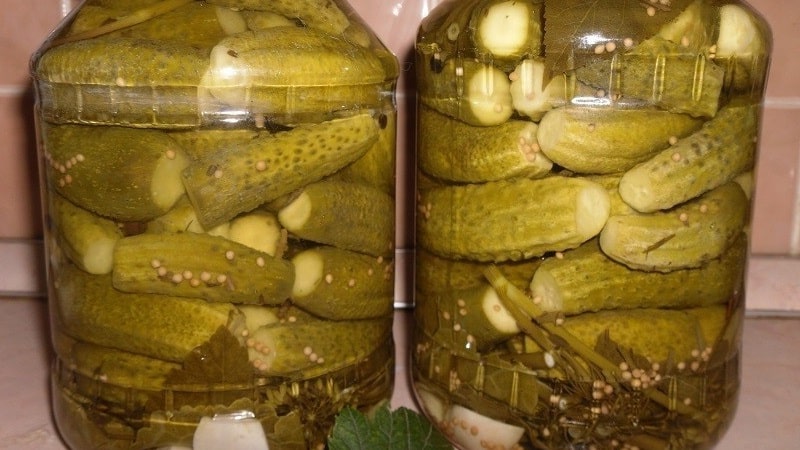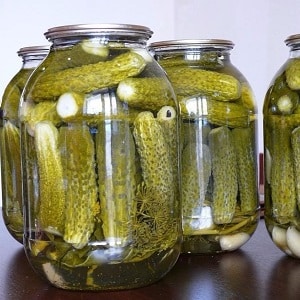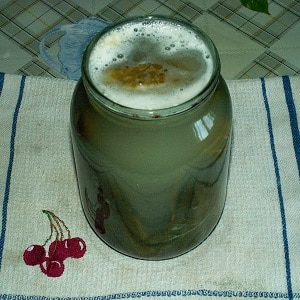What to do if the cucumbers in the jar become cloudy: how to correct mistakes and prevent them in future preparations
What disappointment do housewives experience whose conservations have not stood the test of time. So much effort and products were spent - and all in vain. But don't despair so quickly.
In this article, we will look at the main reasons for vegetable spoilage and how to correct the situation if the cucumbers in the jar become cloudy.
Causes of cloudiness in jars of cucumbers
Before answering this question, you need to remember which procurement rules may not have been followed.
Let's consider main mistakes:
 poorly washed jars - perhaps there are pieces of food or dust left on the walls, or poorly rinsed detergent;
poorly washed jars - perhaps there are pieces of food or dust left on the walls, or poorly rinsed detergent;- cucumbers that are not clean enough;
- poor quality lids;
- using iodized or sea salt instead of regular salt - such salt contains substances that spoil the brine;
- improper storage of the finished product - the workpieces cannot be left for several days at room temperature;
- damage to the can - you may not notice small cracks in the neck area;
- in rare cases, the cause may be a mixture of several varieties of cucumbers that are not intended for marinade.
Cucumbers for preservation have a rich dark green color. They should taste slightly sweet and be medium in size.
How to save workpieces
What to do if the brine becomes cloudy? In some cases, the marinade can be saved, and the work will not be in vain.
There are several ways:
- Give the rolled up jars some time.There is a small chance that the lids will not swell and you will end up with fermented cucumbers. These vegetables can be used in making soups.
- Open the jar after boiling a kettle of water. Pour out the old liquid and rinse the vegetables with boiling water (you don’t have to remove them from the container). After 5 minutes, pour the water into the pan and make a new brine, adding a little more vinegar.
- Pour the brine into a clean saucepan and boil it for at least 5 minutes. Then pour it over the cucumbers, pour it back into the pan, bring it to a boil and only then pour it into the jar. Cucumbers can also be sterilized. In this case, the taste will be slightly different from the classic one.

When can you eat cucumbers from cloudy brine?
Before you take this brave step, remember that There is always a possibility of botulism bacilli getting into the jar. At best, you can get away with an upset stomach.
Important! Botulism is a serious, fatal disease. Do not neglect the rules for storing the product. It is better to throw away the missing vegetables and make a new preparation.
In some cases, eating cucumbers from cloudy brine is possible:
- if the solution became cloudy within a few days after preparation and the methods we indicated later helped;
- if the liquid changed color a little later and the lid did not swell;
If both signs of fermentation are present (bloated lid and poor brine), then under no circumstances should you eat cucumbers and try to “save” them.
Read also:
How to pickle cucumbers correctly so that they do not become cloudy
You will need 1.5 kg of cucumbers and 1 liter of water, 2 cloves of garlic, a horseradish leaf and 2 tbsp.l. salt, ground black pepper, currant leaves as desired.

Advice. It is better to fill the jar as tightly as possible and fill it completely with water.
First, rinse the ingredients well and sterilize the container. Place horseradish leaves, currants, and coarsely chopped garlic on the bottom of the jar. Pack the cucumbers tightly.
Fill the jar halfway with cold water. Prepare a saline solution and add it to the cucumbers until the container is completely filled. Close with a tight nylon lid and put in a cool place.
How to quickly and easily pickle cucumbers
To the question of why pickled cucumbers in jars become cloudy, there is one answer - a violation of the preparation technology. When preparing cucumbers, you must follow the recipe exactly..
Ingredients:
 cucumbers - 1.5 kg;
cucumbers - 1.5 kg;- garlic - 3-5 cloves;
- horseradish or currant leaves - 2 pcs.;
- bay leaf - 2 pcs.;
- dill - 2 bunches;
- salt - 2 tbsp. l.;
- sugar - 2 tbsp. l.;
- vinegar 9% - 1.5 tbsp. l.;
- allspice - 2-3 peas.
Cooking method
The main thing is to rinse the jar and food well. The recipe is designed for a 3 liter container. Place garlic, pepper, currant and horseradish leaves, and bay leaf on the bottom of the vessel. Place cucumbers on top - more will fit in the jar if you lay them vertically, pour boiling water over them and let stand for 10 minutes.
Then drain the water and refill the container with boiling water. After 15-20 minutes, pour the liquid into the pan, pepper and salt. Bring to a boil, pour brine over the cucumbers. Add vinegar, roll up the jar with a sterilized lid and turn it over.
Take note:
Secrets of quick preparation of pickled cucumbers
Advice from experienced housewives
Annual preparations in large volumes allow you to develop your own patterns and secrets of preserving vegetables until spring.
Experienced housewives give these recommendations:
 To minimize the risk of the jar swelling, add some mustard seeds. They will also help make the vegetables firmer and crispier. When the jars of pickled cucumbers and mustard seeds have cooled, they are put away in the cupboard until winter.
To minimize the risk of the jar swelling, add some mustard seeds. They will also help make the vegetables firmer and crispier. When the jars of pickled cucumbers and mustard seeds have cooled, they are put away in the cupboard until winter.- If you want to protect your preserves from mold, place a couple of thin slices of horseradish under the lid. Horseradish root will act as an additional preservative; with it, the marinade will not darken or become cloudy.
- Alcohol stops fermentation processes and kills mold fungi better than any other natural substance. It is enough to add 1-2% vodka (40% alcohol, odorless moonshine) of the amount of water to the marinade or brine to avoid vinegar, which affects the taste of cucumbers.
- Do you want to make cucumbers more juicy and crunchy? Then find a small piece of oak bark, boil it first and add it to the jar. Crushed oak bark is sold in paper packages in pharmacies. Keep in mind that the bark makes the cucumbers a little darker than usual.
- If you need the cucumbers to pickle faster, cut off the tails or prick them with a fork.
- If you use screw caps, there is no need to turn the jars over. Turn over the jars, closed with machine lids, and cover them with a blanket.
Conclusion
If you follow all the cooking rules, then there will be no spoiled jars with cloudy brine. Carefully monitor the cleanliness of the products, sterilize the jars in advance and under no circumstances consume spoiled preserves. It’s better to do the pickling again than to get poisoned.